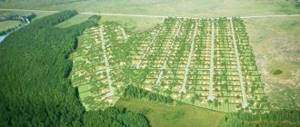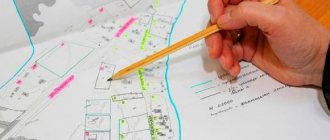What is topographic survey and what does it include?
Topographic survey (TS, topographic survey, geo survey) of a locality or a specific land plot is a set of works to create topographic plans based on the received readings of geodetic points of the area on which the object is located.
Obtaining spatial data about the area may be necessary for: surveying and designing buildings, updating topographic maps, obtaining building permits, drawing up general plans and working drawings, gasification, electrification and laying other communications, as well as when designing landscape design.
The work is completed with a simulated map and topoplan of the study area at the required scale with conditional markings. The choice of scale depends on the task for which a topographic map is needed.
Topographic survey is the main part of engineering surveys for construction and comes in different types: tacheometric, analytical, sonar. The main differences between these types are: purpose, scale, equipment used, as well as some other parameters.
We construct topographic plans in accordance with the selected classification:
- by scale:
- small-scale: 1:10000, 1:25000, 1:50000;
- large-scale: 1:100, 1:200, 1:500, 1:1000, 1:2000, 1:5000.
- type:
- aerial topographic survey;
- ground;
- surveying of underground communications and engineering networks.
electronic theodolite
If you need topographic survey on a specific scale, indicate this in the application, in this case, the construction of maps and plans will be carried out taking into account these requirements.
Geo Plus Project LLC has more than 15 years of experience in carrying out topographic survey projects , and its leading specialists are surveying engineers for more than 25 years.
We have reliable modern geodetic equipment in our arsenal, which allows us to measure distances and angles and determine coordinate points with extreme accuracy.
Types and scale of topographic surveys of the site
Most often, our company orders a vertical survey of a plot of land for design. It is taken as the basis for design when developing a master plan for a settlement and making adjustments to it, working on the landscape and landscaping of the territory, and designing construction.
We carry out topographic surveys of areas of different scales:
- 1.small scale (1:10000, 1:25000);
- 2.large scale (1:500, 1:1000, 1:2000, 1:5000);
- 3.extra-large scale (1:50, 1:200).
To design a land plot, depending on your goals, we recommend choosing the most appropriate scale and type of topographic survey.
- Improvement of the territory (city, street, yard) or changes in the landscape on it. The basis for such a topographic survey of the site is optimally based on a scale from 1:50 to 1:200 (0.5-2 meters in one centimeter). The choice of survey design scale depends on the terrain, its area, and the degree of infrastructure development. On a large-scale plan, we display in detail the entire territory and the objects located on it, for example, trees and small architectural forms. Such a design plan will be clear and convenient for the work of landscape designers of the land plot.
- Drawing up a master plan for small settlements, large industrial enterprises, hydraulic structures and power plants requires surveying the area at a scale of 1:2000.
- Reconstruction and planning of territories of large cities and rural settlements, design of highways, railway lines at the design stage. The topographic survey is drawn up using scales of 1:5000, 1:10000.
To get a consultation
The greatest demand is for topographic surveys of land plot design at a scale of 1:500:
- The construction of multi-storey buildings and other capital buildings, the laying of communications (including underground) require the development of a master plan on a scale of 1:500 (1 cm = 5 meters). The height of the relief section is half a meter.
- Registration of a land plot and real estate for cadastral registration will also require ordering a topographic survey of the site at a scale of 1:500. The plan will show trees whose trunk thickness exceeds 5 cm, detailed terrain (hills, ravines, rivers, etc.), communication lines, buildings. The location of communications is coordinated with resource supply and utility services.
- Connections to life support networks. A scale of 1:500 will give a visual image of the boundaries of the site, buildings on it and communications. Planned water supply networks, for example, are drawn to the location of the intended connection. The document is being approved by resource supply organizations.
- Tree topographic survey at a scale of 1:500 for: landscape construction, house design, forest management work. All trees with a trunk thickness of more than 5 cm are subject to taxation; their height, thickness, and species are indicated.
- Topographic survey of utility networks. All underground and above-ground communications in the territory are indicated with their technical characteristics, route profiles and a diagram of service points. Filming is coordinated with resource supply and utility services.
- Topographic survey of linear objects: communication lines, power supply, railways and roads. The peculiarity of topographic survey is detailed field and office tracing, offering options for the optimal passage of the communication line.
- Obtaining a building permit. Based on the topographic survey of the site, the following are drawn up: an urban planning plan (GPZU) and a site diagram with symbols. For a construction permit in Moscow, the topographic plan is subject to approval by Mosgorgeotrest, and in the Moscow region no additional approvals are required except with the holders of communications.
A topographic survey of a plot of land for these or other purposes will be carried out.
Photo 1. Theodolite.
FIND OUT THE COST OF WORK
Carrying out geodetic work with your own hands
If you need a simple site plan showing existing buildings for landscaping, then in order to save your budget, you can do geodetic work yourself. Using these measurement results, you can create a design project for your site. Of course, geodetic work performed by specialists will be more accurate compared to independent measurements. The results of geodetic work performed by specialists can be used to prepare official documents.
Tools and accessories
To perform geodetic work with your own hands, you will need the following tools and devices:
- Form B6 cadastral passport (if you have one);
- graph paper;
- protractor, compass;
- compass;
- wooden pegs 1.2 - 1.5 m high;
- hydraulic level or building level;
- rope;
- flat board;
- sledgehammer or hammer.
Determining the boundaries of the site
To carry out topography with your own hands, Form B6 of the cadastral passport can help you. It indicates the exact dimensions of the site, its coordinates, as well as the angles of rotation of the site boundaries. This information can be used as the basis for constructing a simple site plan.
If you have a cadastral plan , then it is better to first transfer it to your plan at the scale you need. And then, according to this plan, transfer it to the area.
If you do not have a cadastral plan , but you know the boundaries of your plot, then first we mark the boundaries of the plot on the ground, and then transfer them to our plan.
The plan can be drawn up electronically or drawn on paper. If you are drawing up a plan on paper, then it is better to use graph paper for these purposes.
Our plan needs to be oriented according to the cardinal directions. A point on the ground is described by three parameters: X, Y, Z. X and Y determine the position of the point in the plane. The X axis shows the north direction. The Y axis defines the east direction. Z axis – shows the position of the point in height. By connecting points on the XY plane, we get a site plan, and the Z coordinate will allow us to describe the terrain.
The ideal option would be if your plot had a regular rectangle or square, but this happens extremely rarely. As a rule, the areas have an irregular shape. In this regard, difficulties arise with constructing a site plan. So, let's begin to figure out how to properly build a site plan.
On the plan, draw the boundaries of the site taken from the cadastral plan and use them as a basis for further construction. Choose the base side. The base side is the side parallel to which we will make all measurements for the project. In general, it is better to choose the longest side of the site as a basis.
Constructing a site plan with a simple quadrangle shape
If your plot shape is quite simple and has a simple quadrangle, then you can get a large-scale plan of the plot by following these steps:
- We draw the base line AB, placing it parallel to the millimeter grid.
- From vertex A, using a compass, we draw an arc with a radius equal to the length of the front part of section AG.
- Similarly, we outline the arc with a radius corresponding to the length of the back side of the section from vertex B.
- Using a compass, we outline an arc equal to the diagonal of the section from vertex A to B. At the intersection of arcs AB and BV, we obtain point B.
- From point B we draw an arc equal to the length of side VG. At the intersection of arcs AG and VG we obtain point G.
- By connecting points A, B, C and D with segments, we obtain a site on a scale that corresponds to the shape of our site on the ground.
Building a site plan with a complex shape
If you have a site with a complex configuration, then divide it into several simple figures in the shape of a quadrangle or triangle. Do the same steps as described above for each figure. As an example, let’s take the following figure, as shown in the figure. Its shape is quite complex. We will have to divide our site into 2 parts: quadrangle AGDE and triangle ABC. First we will form a quadrilateral as described above, and then a triangle.
- We draw the base line AG, placing it parallel to the millimeter grid.
- From vertex A, using a compass, we draw an arc with a radius equal to the length of the front part of section AE.
- Similarly, we outline the arc with a radius corresponding to the length of the rear side of the section from the top of the main body.
- Using a compass we outline an arc equal to the diagonal of the section from vertex A to D. At the intersection of arcs AD and GD we obtain point D.
- From point D we draw an arc equal to the length of side DE. At the intersection of arcs AE and DE we get point E. We have obtained all the points of our quadrilateral AGDE.
- Let's start identifying the points of the triangle. On the side AG we lay off the segment AB and get point B.
- From point B we draw an arc with a radius equal to segment VB.
- From point A we draw an arc with a radius equal to segment AB. At the intersection of arcs AB and BV we obtain point B.
- By connecting points A, B, C, D, E and E with segments, we obtain a site on a scale that corresponds to the shape of our site on the ground.
To obtain this plan, you can use a protractor instead of a compass. Instead of serif arcs, use a protractor to lay out the corners and set aside the corresponding segments of the sides of the area.
Line the resulting plan into squares with sides corresponding to the grid sizes of your future measurements on the ground. The grid size on the ground is usually 10, 20 or 40 m. This depends on the degree of accuracy required.
Shooting a site on the ground.
It is better to carry out all measurements of the site together.
We determine the location of the site relative to the cardinal points and mark it on the plan.
We assign the perimeter of the site as follows:
- Determine the first base point. This is a point that you can accurately determine on the boundary of the site, preferably located on the baseline. For example, on our site you can take the corner of the yard as this point. We drive in the first peg.
- We try to visually determine the height of the relief at this point relative to the entire area. Mark the horizontal level on the peg. If this point turns out to be low in relation to other points on the site, then we place the mark above the middle of the peg. If it is high, then we place the mark closer to the ground. We will consider this mark to be the zero level. If further measurements are above this mark, they will have a positive value. If – below, then negative.
- We measure the height from the ground to the mark on the peg. We record the resulting measurement on our plan.
- Using a compass, we determine the direction of our site boundary line. We hammer in the next peg at a distance corresponding to the side of the grid square.
- We connect two adjacent pegs with a rope. The rope should be in a taut position without bending and horizontally. We obtain the horizontal line of the rope using a board and a building level. Place a level on the board and level the board horizontally. Our rope should go along the board. We fix the rope on the peg.
- Place a horizontal level on the peg. We measure the distance from the ground to the mark on the peg and record the result on our plan.
After taking measurements along the perimeter, we make a grid of squares throughout the entire area. The sides of the squares are usually taken as 10, 20 or 40 m. The size of the side depends on the features of the relief and the degree of accuracy of its display.
Thus we have a plan indicating the heights. The height of the points can be either positive or negative. A positive value means high ground, a negative value means low land.
It is more convenient to mark the elevation levels of the site, starting from the highest point. If your starting point when starting to set off the perimeter of the site is not the highest point, then it will be more convenient to first set aside the entire perimeter of the site, and then mark the height of the points on the site, starting with the highest.
When marking a new point, each time we evaluate the terrain to neighboring points. If we see any features in the area, we mark them on the plan. To do this, we install additional pegs and additionally measure the level to increase the shooting accuracy. This is the basic principle of topography - you need to describe the terrain with pickets at approximately equal distances, adding pickets in those places where it is necessary to increase the accuracy of the survey.
When taking measurements of the site, it is also necessary to mark all the buildings located on the site. And also note all significant vegetation.
It is necessary to determine the road and path network and mark it on the plan.
You also need to determine wind zones: where the winds blow most often, where the strongest winds come from, where wind calms occur. Mark all this on the plan.
Equally important is observing the sun. It is necessary to note sunny and shadow areas.
The procedure for conducting topographic surveys
Stages:
- 1.Preparatory stage. After the conclusion of the contract, the terms of reference are approved. If archival materials exist on a site, surveyors analyze and study them. A permit for topographic survey of the site is issued.
- 2.Field topographic work. EcoExpert surveyors visit the area to explore the territory, draw up a topographic plan using a ground or aerial photo topographic plan
Photo 2. Aerial phototopographic methods are also used to survey large areas. - 3. Office work. This stage involves drawing up the necessary plans and maps using data obtained during field work and studying archival documentation. Surveyors will display on the map all communications, objects on the ground and even vegetation, if this is indicated in the technical specifications.
The final document will contain objective and reliable information about the land plot with relief designation. The detail of its preparation affects the cost of the work. But the price is justified, because as a result you receive a detailed design plan - real instructions for the designer.
To get a consultation
Where can you order a topographic plan of a land plot?
Today there are a lot of private geodetic organizations and individual geodetic engineers who are ready to perform topographic surveys and office work and create a topographic plan of a land plot as the final result of the labors of their righteous people. But do not forget to ask both of them for a license for such types of work.
And in order for an organization or individual to start work, they must provide them with the following documents:
Topographic plan of the land plot
- technical task; (looks like this) (usually filled out by you or the geo-company on their form);
- title (or title) documents for the land and objects of all co-owners;
- if available, BTI technical passport (if there are buildings);
- photocopy of passport (or copy of constituent documents);
- a copy of the power of attorney (if it is not the owner of the site who orders).
Application of topographic survey
Depending on the purpose of the topographic materials, the survey scale with the required level of detail in the design of the land plot is selected.
General development plan, updating maps of settlements, laying communications, communication lines, registering a land plot with cadastral registration - all these actions require the preparation of topographic materials based on the survey results.
Communications, buildings and structures, relief, vegetation, and water bodies are clearly visible on maps and plans. Therefore, the range of their application is very wide.
Result of topographic survey
Where can I get a topographic survey? From the performer. He must hand over the completed topographic plan to the customer. The plan is usually drawn up on paper or electronically (a digital model of the site is built). The scale of the plan can be different and vary depending on the size of the site.
Let's talk about the accuracy of the topographic plan. It is understood as the average error in determining the location of a site on the plan. That is, this is the accuracy with which coordinates can be determined on the plan . It is different for each scale.
For flat terrain, the permissible error is 0.5 mm on a scale. Translated into distance for a scale of 1:500, the error will be 0.25 meters. The larger the scale, the smaller the error.
The process of topographic survey in
Direct topographic survey of a land plot for design begins with surveyors going to field work.
Next, work is carried out with documents, including those obtained from archival sources.
All information is drawn up in paper form and in electronic form.
The final stage is the preparation of a technical report on the work performed.
All collected information is coordinated, especially in cases where communication facilities and communication lines pass through the area. To get approval, our company’s surveyors visit all resource supply services, check the accuracy and correctness of communications. The approval is indicated by the seal of the department and the signature of the responsible person.
The unified technical report is submitted to the city architecture department. After approval, it can be used for the stated purposes.
The report, results of topographic survey in paper and electronic form, other documents and information are transferred to the customer.
Stages of topographic survey in the Moscow region
- First of all, our specialists study the available documentation (Technical specifications, situation plan) provided by the customer;
- The cost of the work and the realistic deadlines for its completion are agreed upon.
- Then work is carried out on the ground. With the help of geodea, as well as all above-ground and underground objects located on the territory;
- A thorough search and examination of underground communications is carried out, followed by their coordination with the operating services.
- Based on the information obtained as a result of surveying the land plot, a topographic plan and a technical report on the work performed are drawn up;
The topographic survey results are valid for 2 years. After this time, measurements must be taken again to update the existing data.
As a rule, the shooting scale is 1:500, but can be changed in accordance with the customer’s specifications.
Geodetic work involves the use of electronic tacheometers and GPS systems.
Documents for surveying a land plot
To begin work, you need to submit an application to the city department of architecture. At the moment, the application has a notification nature, but to examine the report, you will need the architect's seal. To receive this mark, you must present:
- Work contract;
- Terms of reference for the contract;
- A document confirming that the company is a member of a self-regulatory organization;
- Work program.
After the work is completed, changes are made to the architecture tablets, and one copy of the report is submitted to the city administration.
The application must be taken seriously, otherwise the filming will not be approved and used for the stated purposes.
Equipment for topographic survey
Our surveyors use professional, high-precision equipment. Thanks to this equipment, we receive reliable and accurate information, therefore, we compile a topographical survey of the site that is competent from all points of view.
Our equipment:
- Electronic tacheometers. These high-precision devices consist of a built-in computer, a protractor and a light rangefinder. They are designed to determine horizontal and vertical angles, distances and save measurement results for their subsequent unloading and processing in the program.
- GPS receivers. Satellite receivers are needed to determine the height and exact coordinates of the starting points. The effectiveness of the equipment is reduced if the shooting is carried out in an area where satellite signal reception is difficult. This could be a forest plantation; interference is also caused by buildings and large industrial facilities in the construction of which metal building elements were used.
- Line finders are designed to locate linear features located underground to indicate them on a topographic survey for design purposes. The router determines the location of pipelines and cables (regardless of whether they are energized or not).
will carry out topographical surveying and design in Moscow and other regions of Russia at a professional level. We have all the necessary resources: qualified surveyors, high-precision equipment and design experience.
We are waiting for your call to start cooperation! Call us toll-free or 8 (499) 647-44-56. Check out examples of completed work and the cost of engineering surveys and design work.








